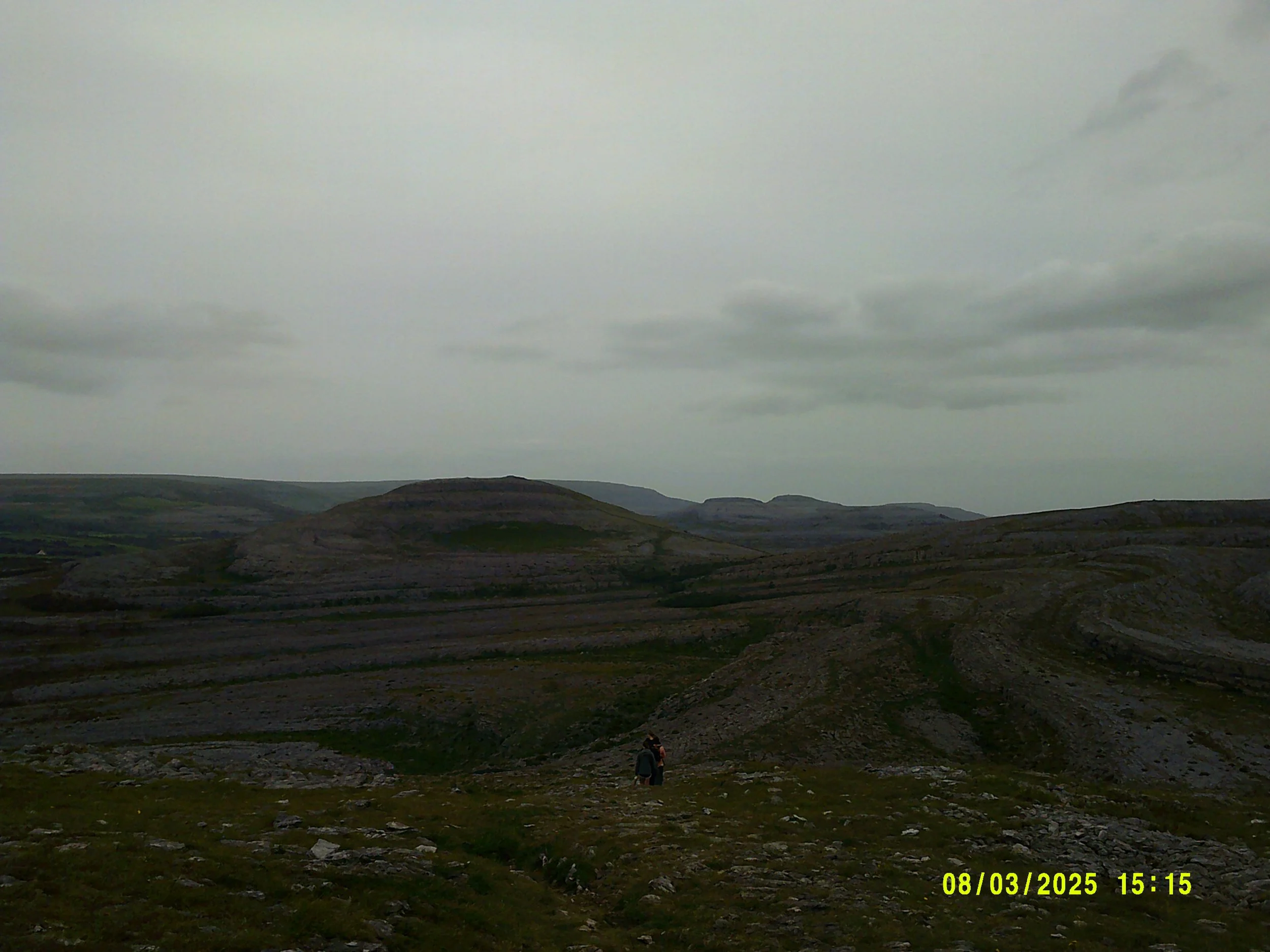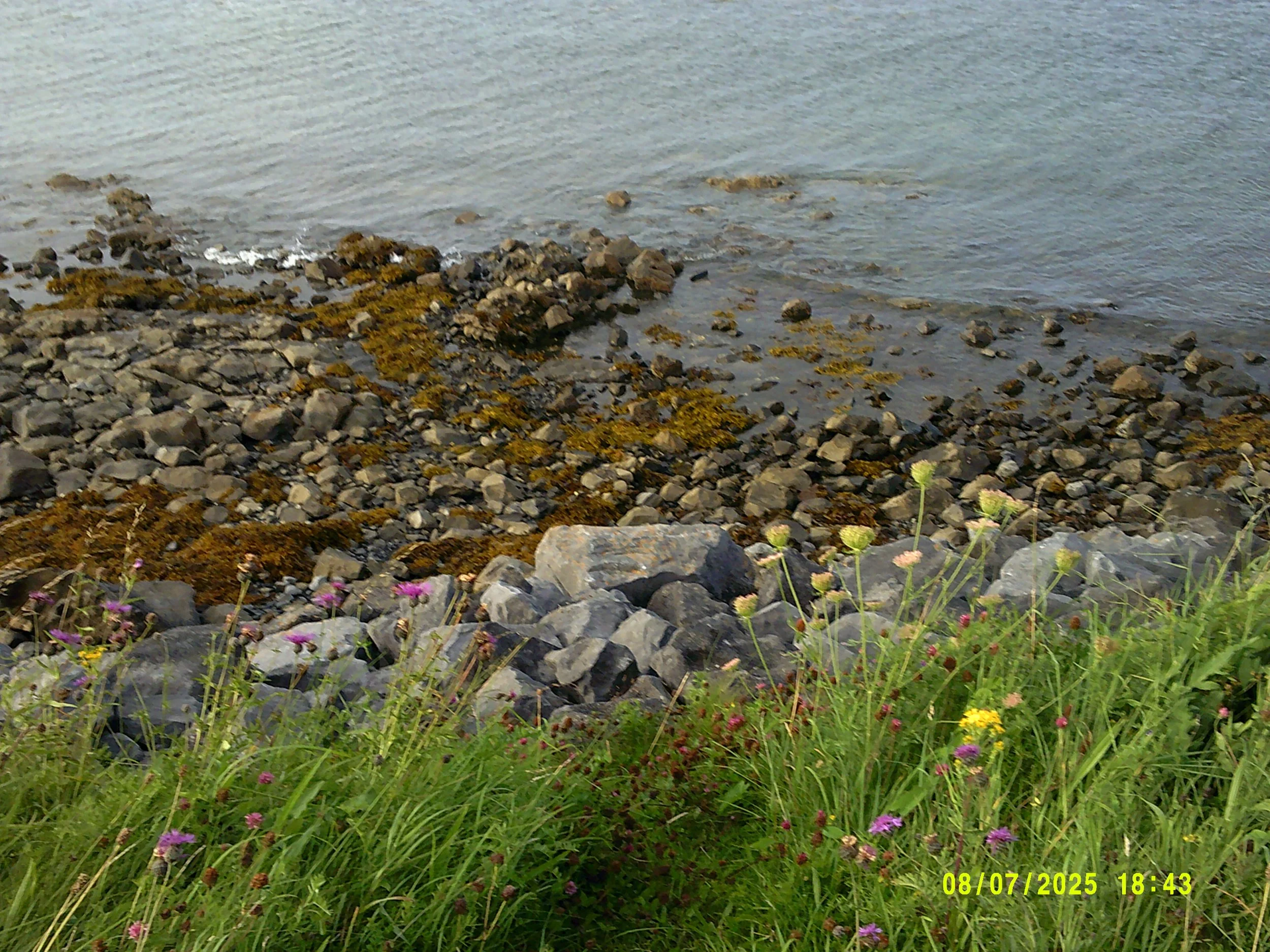Entry Nine: Land and Loving It
Like most everything I write, this is about a feeling. The one I felt radiating from the limestone as I traversed mountains, and sensed in the quiet care the people carried in every action. I even felt it in their passive-aggressive scoldings of our sad attempts at recycling. It’s the rhythm of the area, the heartbeat of the poetry which flows through it. It’s as natural to the Burren as the purple and yellow flowers growing wild in the grass like sprinkles.
Beautiful Burren Wildflowers
The month I spent in The Burren was one of the most unique of my life. In a house with people I’d never met, going to a school I’d only learned of months prior, doing things I’d never done before, I strangely found myself more comfortable than I am on a daily basis. I think this was partly because my goal for the trip was to step completely out of my comfort zone. But it also might’ve been because I wasn’t surrounded by any of the things that usually gave me anxiety. I was so out of my comfort zone that I wasn’t sure what to be anxious about yet, so I found myself oddly at ease. Thanks to this, I was open to almost anything, and this openness led me to the feeling I’m trying to describe to you now.
One of the new things I tried on the trip was hiking. I—born and raised in New York, moved to Boston for college, had only seen the tops of mountains from a car passing by—was the novice of the group in terms of hiking skills. I lagged behind during trips up mountainsides, stopping to catch my breath as my peers traversed the terrain seemingly with ease. I never felt less than for my lack of hiking abilities, because thankfully, I was with some of the kindest and most encouraging people I’ve ever met. But I did find myself picking up on things I might not have had I been up ahead with the pack. The only way I could survive struggling up the mountain was by focusing on the little details around me that made the trip to the top worth it. Like how the hazelwood trees twisted between each other, and the cool sun poked through the branches. Or how grass sprouted between stones, soon growing over the rocks completely, hiding them like landmines on the trail, ready to trip some weak-ankled rookie like me.
From Our Hike Up Mullaghmore
The more I walked, hiked, and stumbled through the west of Ireland, the more I understood why the people at the college were such tyrants about recycling; why they spoke of their grass, which was not so different from my grass in the Boston Common or Central Park, as if it were scared, holy. There is a beauty there that is innumerable, unexpressable. You truly have to see it to believe it. But simultaneously, it is like any other beauty, its trees and stones— flowers, water, and cows. The things that make the Burren so unique to me were things I could technically find anywhere. And yet, I was struck by it in a way so different from anything else.
A Full Turlough On The Way Home From Class
Forgive me if I mysticize it, I’m trying hard not to. It’s difficult to talk about the Burren without sounding like you’re making a myth because when you’re there, it’s almost like you’re in some other, altered dimension. On days when the sky is clear, and the sun shines across the long stretches of fields of cows and sheep, the gray mountains hovering in the background touching the sky, you can’t help but feel like such beauty only exists here. And in some ways it does, there are very few places left on earth with as much biodiversity as the Burren. Nowhere else can you find limestone hills with layers stacking upon themselves like swirls of ice cream starting to melt. But at the same time, the Burren isn’t outer space. It’s not its own planet. It’s a small part of our large planet, a snapshot of the simple beauties that scatter the earth. Its contoured hills and fragmented cliffs paint a picture so unique that you’ll take a thousand photos of it, but in essence, is it really so different from the terrain I walk at home?
I’ve never considered myself much of an environmentalist. I care about the earth as much as the average person my age, sometimes more, sometimes less. I try (and sometimes fail) to recycle. I take the Amtrak over a flight when it’s less expensive. I buy plastic water bottles when I need them, but I refill them at least twice before I buy another. Despite my failures at environmentalism, nature has played an essential role in my life and well-being. I look to it when it all feels too much, when I’m overwhelmed and I need to find peace, when I need to strip myself down to the essentials. I sit in parks and on river banks, and I read or listen to music. I find peace picking blades of grass out of the dirt and mushing them between my fingers. I go to Jamaica every year and I lie on beaches, some public, most private, digging my feet in the sand. Wading in crystal waters, I think to myself, “This is all I need forever.”
Then I go home and forget. I go back to my house on my dead-end street, and I fight with my family about what I think and how I feel. And afterwards I can no longer recall the warm feeling of the cool breeze because I’m too stuck in my head. I go back to my dorm, suspended hundreds of feet above the street, and I worry about jobs, and classes, and a future I can’t imagine, because in the back of my mind, I worry that in ten years, there will be no life as we know it now. That there will only be disaster and famine, there will only be catastrophic proportions, but despite this, I still worry about things I don’t believe matter because in the dorm suspended hundreds of feet above the ground, those are the only things that can exist to me.
The Backyard at Meadowfield BnB
In the Burren, you have no choice but to be in tune with your environment. The weather is so unpredictable that the app can’t ever give an accurate forecast. You must be able to sense the rain, or the clothes you hung out to dry will only get wetter. You need to be able to read the wind and determine whether or not today's a good day to go out on the water. You have to know that the sun, despite its perceived shyness, is fierce and unwitting once you get higher up the mountain. You have to take a step back and feel, or else you’ll be off balance.
In the winter, most farms keep their animals indoors in barns and pens to protect them from the cold. In the Burren, they do the opposite. Farmers instead bring their livestock up the limestone mountains for the winter to graze and live. This is because the limestone absorbs heat from the sun, which keeps the animals warmer than they might be in the barn. And because the animals do most of their grazing on the mountains in the winter, the flowers, plants, and insects native to the area thrive on the mountain top in the summertime, leading to more biodiversity and a healthier ecosystem. The practice is contrary to many other places' “Winterage” procedures, where they move cattle up the mountain in the summer, and back down during the winter. But the Burren's Winterage works alongside its environment instead of in opposition to it, which benefits the animals, the ecosystem, and the farmers.
It’s this connectedness, and the subtle ways you have to be in tune with life. The quiet way people live in harmony with the land. Their deep knowledge of its history, their understanding of its quirks. It reminds me of a lot of indigenous environmental practices and connection to the land. It’s something I’ve heard and read about so much, but to see it and feel it is entirely different. It’s a practice fueled by such love that it’s no longer a practice, it’s just life.
Limestone Shore and Wildflowers In Ballyvaughn
I’ve brought this feeling back home with me. This unremarkable beauty, this mystic psyche, this instinctive love for the land. It’s fading wake leaves behind two things: gratitude and wonder. I can’t express how grateful I am for the time I spent in the Burren, the people I met, and the things they taught me. And I wonder, can I translate the feeling I felt there, can I bring it with me and plant its seed between the cracked concrete out front of my house? What does it mean to be in tune with the asphalt beneath my shoes as I rush to class? How would that manifest in my actions and my practices? Will I start being able to sense when the rain is going to come, and decide to wear my raincoat that day? Can I let it make me softer, kinder, more apt to change the things that I’m told to hate?
Right now it feels like a big wish. It’s something I want, but I have almost no idea how to get it. I want to love my land as much as the people in the Burren do, despite its misgivings and its flaws. I know I can, because like everywhere on Earth, the Burren isn’t perfect. It’s probably easier to love the imperfect place when it’s a flourishing, diverse ecosystem, and not a crumbling city, but still, I have hope. I want it to make me compassionate, and more open to the movements of life. If you’ve spent any significant time with me in the last few years, you’ve probably heard the words, “I hate Boston/New York” leave my mouth. And while I feel this way most days, it isn’t really true. I don’t hate them, I love them, and what upsets me is that I can see the potential in these places. I see the seeds of flourishing, happy, equitable cities, but the people who run them and even some of the people who live in them don’t seem to care. And so most days, the fondest I feel for the places I spend my life feels more like anger.
But as much as I might try, my hatred for a place won’t change it. It might motivate me, temporarily, to get up and do something about it, or to go somewhere else. But soon it’ll weigh me down. I’ll grow tired of carrying it, and it’ll calcify to apathy. An unforgivable feeling, one that isn’t carried but carries you. And so I have to try to feel the love I have for it, despite the hideousness; I have to love it.
I think I’ll start by just liking it.




